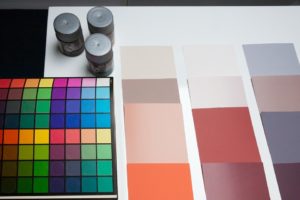Whether you’re trying to keep your home trendy or put your business’s best interior design foot forward, color means everything.
Color sets the mood for a room, and it can instantly make or break a first impression based on how well or poorly the color palette works for that space.
The trickiest part is that the effectiveness of a color palette depends heavily on rapidly changing design trends – and keeping up with these can be a headache.
But the good news is that, with the right preparations, it’s simple to set yourself up so that you can always stay on top of these trends and come out ahead.

Do your research
Color trends can change in what might seem like a heartbeat – and if you’re not aware of it, you’ll be quickly left behind.
Plenty of sources can give you a good idea of the types of colors that are in or out.
Far more vital than that, though, is to understand what has made these colors popular, what ways these colors are being added to spaces, and what businesses and designers are trying to express by using them.
In other words, it doesn’t help to just throw a bunch of trendy colors together in a room if it’s still sending the wrong message to visitors or potential customers.
Neutral isn’t always boring
The place to start with just about any space is the neutral colors – and one of the better recent color trends is that today’s neutrals aren’t just a collection of barely discernible off-whites.
Neutrals can be thought of as a more stable base to which you can add bold colors that might be part of short-lived trends.
Thankfully, neutral isn’t just a hodgepodge of soulless whites and grays anymore, as recent trends have added warmer hues and even metallic elements into the mix.
If you don’t want to risk painting an entire room with stark colors that may fall out of favor as soon as they appear use the expanding definition of “neutral” to your advantage – and work from there.
Accessorize for accents
Since going bold on wall colors and other more immutable surfaces can be risky, accessories are perfect for adding trendier colors to a room.
The balance here is that colorful accessories give a lot of personality to a room while being easily replaceable – so when the color’s out, so is that now-ugly throw pillow.
Rugs, runners, and pillows are popular choices for colorful accessories, of course – but you can get creative with the items you use to accessorize in a room, too.
This can include decorative plates in a kitchen or dining room, furniture for your home office, and light fixtures in other common areas.
It all depends on what’s in a given room – but the bottom line is that the more replaceable something is, the easier it is to use that to your advantage by incorporating even the boldest color choices.
Add texture
If you’re still apprehensive about going overboard with a blindingly diverse color palette, try working more with different textures.
Differently textured and patterned items can draw out interesting contrasts without inducing headaches.
What’s more, though, this can let you zero in on one or two particularly appealing colors without overloading visitors with too much of the same thing.
Flexibility
Overall, the key to staying on top of color trends and using them to your advantage is to keep the spaces in your home or place of business as flexible as possible.
Using safer colors as your base and building on top of this with the bolder color and texture selections means you’re always ready to change things around at a moment’s notice.
So while staying on top of color trends might seem difficult, adhering to these simple principles goes a long way toward making the spaces you’re designing say all the right things about you or your business.